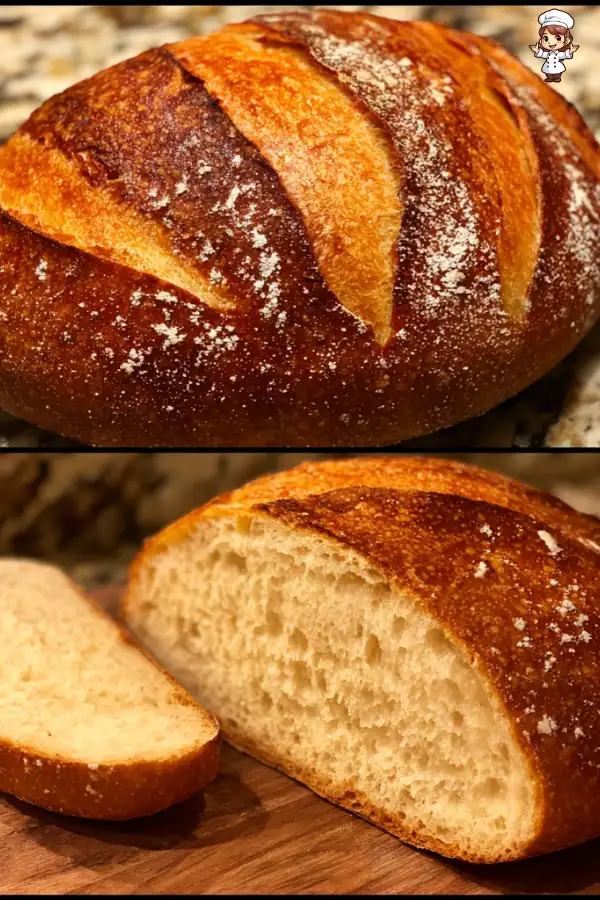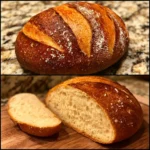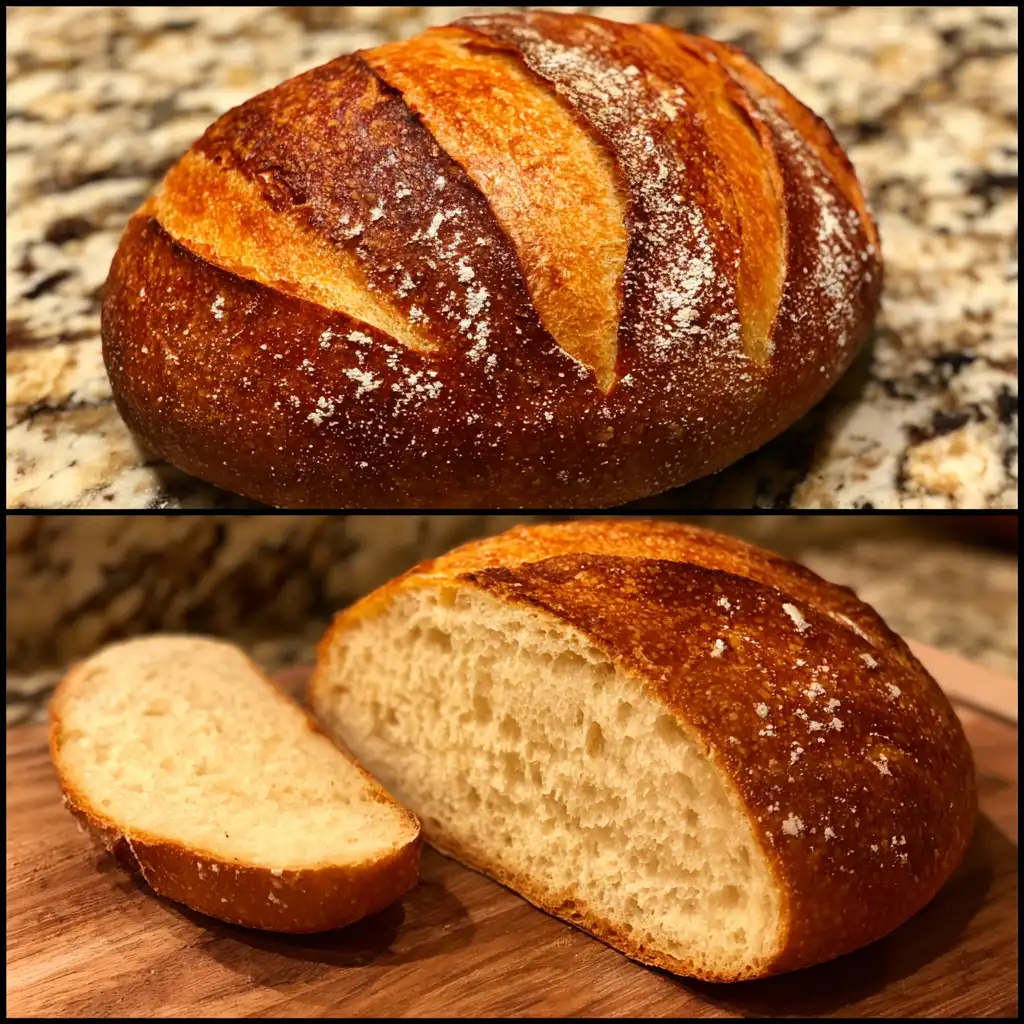Sourdough bread is a type of bread made through a natural fermentation process. Unlike regular bread, which uses commercial yeast, sourdough relies on wild yeast and bacteria present in the environment. This unique fermentation gives sourdough its distinct tangy flavor and chewy texture. The process starts with a sourdough starter, a mixture of flour and water that captures wild yeast. Over time, this starter becomes bubbly and active, ready to leaven your bread.
One of the most exciting aspects of sourdough is its versatility. You can create various flavors and textures by adjusting the ingredients and fermentation times. Whether you prefer a crusty loaf or a soft sandwich bread, sourdough can be tailored to your taste. Plus, the long fermentation process breaks down gluten, making it easier to digest for some people.
The Benefits of Making Sourdough Bread at Home
Making sourdough bread at home offers numerous benefits. First, it allows you to control the ingredients, ensuring that your bread is free from preservatives and additives. You can choose high-quality flour and adjust the hydration levels to suit your preferences. This control leads to a healthier loaf that you can feel good about eating.
Another advantage is the satisfaction of creating something from scratch. The process of nurturing your sourdough starter and watching your dough rise can be incredibly rewarding. Plus, the aroma of freshly baked bread filling your home is hard to beat!
Additionally, homemade sourdough bread is often more affordable than store-bought options. With just a few simple ingredients, you can produce multiple loaves, saving money in the long run. Lastly, sourdough bread has a longer shelf life due to its natural acidity, which helps to preserve it. This means you can enjoy your delicious bread for days without worrying about it going stale quickly.
Ingredients for Sourdough Bread Recipe
Essential Ingredients for Sourdough Bread
To create a delightful sourdough bread, you need a few essential ingredients. Each plays a crucial role in the bread-making process. Here’s what you’ll need:
- Bread Flour: 500 grams (about 4 cups) of bread flour is ideal. It has a higher protein content, which helps develop gluten, giving your bread structure and chewiness.
- Water: 350 grams (about 1.5 cups) of lukewarm water is necessary. The warmth helps activate the sourdough starter, promoting fermentation.
- Salt: 10 grams (about 1.5 teaspoons) of salt enhances flavor and controls yeast activity. It’s essential for a well-balanced loaf.
- Sourdough Starter: 100 grams (about 1/2 cup) of an active and bubbly sourdough starter is the heart of this recipe. It provides the natural yeast needed for leavening.
These ingredients work together to create the perfect sourdough bread. Each component contributes to the flavor, texture, and overall quality of the final product.
Optional Ingredients to Enhance Your Sourdough Bread
While the essential ingredients are crucial, you can also experiment with optional ingredients to elevate your sourdough bread. Here are some ideas:
- Whole Wheat Flour: Substitute part of the bread flour with whole wheat flour for a nuttier flavor and added nutrition.
- Seeds and Nuts: Adding seeds like sunflower or sesame seeds, or nuts like walnuts, can provide a delightful crunch and extra flavor.
- Herbs and Spices: Incorporate dried herbs like rosemary or spices like cinnamon for a unique twist on traditional sourdough.
- Cheese: Mixing in shredded cheese can create a savory loaf that pairs well with soups and salads.
Feel free to get creative! These optional ingredients can transform your sourdough bread into a signature loaf that reflects your personal taste.
Step-by-Step Preparation of Sourdough Bread Recipe

Step 1: Preparing the Sourdough Starter
Before you start making your sourdough bread, ensure your sourdough starter is active. Feed it with equal parts flour and water about 4 to 6 hours before you plan to bake. This will give it time to bubble up and become lively. A healthy starter is key to a successful loaf!
Step 2: Mixing the Dough
In a large mixing bowl, combine the bread flour and salt. In another bowl, mix the lukewarm water with your bubbly sourdough starter. Stir until well combined. Gradually pour this mixture into the flour and salt. Use a wooden spoon or your hands to mix until a shaggy dough forms. This is the beginning of your sourdough bread recipe!
Step 3: Kneading the Dough
Now it’s time to knead! You can do this in the bowl or on a lightly floured surface. Knead for about 10 minutes until the dough is smooth and elastic. Alternatively, use the stretch and fold method. Stretch the dough from one side and fold it over itself, rotating the bowl as you go. This method helps develop gluten without overworking the dough.
Step 4: First Rise (Bulk Fermentation)
After kneading, place your dough in a lightly greased bowl. Cover it with a damp cloth and let it rise at room temperature for about 4 to 6 hours. You’ll know it’s ready when it has doubled in size. During the first two hours, perform a series of stretch and folds every 30 minutes. This helps strengthen the dough and improve its structure.
Step 5: Shaping the Dough
Once your dough has risen, gently turn it out onto a lightly floured surface. Shape it into a round loaf by folding the edges toward the center. Then, flip it over so the seam is on the bottom. Let it rest for about 15-20 minutes. This resting period allows the gluten to relax, making it easier to shape later.
Step 6: Second Rise (Proofing)
After resting, shape the dough again into a tighter round. Use your hands to create tension on the surface. Place the shaped dough seam-side up in a well-floured proofing basket or bowl lined with a floured cloth. Cover it with a cloth and let it rise for another 1 to 2 hours. For a slower fermentation, you can refrigerate it overnight. This enhances the flavor of your sourdough bread.
Step 7: Baking the Sourdough Bread
About 30 minutes before baking, preheat your oven to 450°F (230°C). If you have a Dutch oven, place it inside to preheat as well. Once the dough has risen, carefully turn it out onto a piece of parchment paper. Use a sharp knife or a bread lame to score the top of the loaf. This allows the bread to expand while baking. Now, carefully remove the hot Dutch oven from the oven, lift the parchment paper with the dough, and place it inside. Cover with the lid and bake for 30 minutes. After that, remove the lid and bake for an additional 15-20 minutes until the crust is golden brown and the internal temperature reaches about 200°F (93°C).
Tips for Perfecting Your Sourdough Bread Recipe
Common Mistakes to Avoid in Sourdough Bread Recipe
Making sourdough bread can be a rewarding experience, but it’s easy to make mistakes. Here are some common pitfalls to watch out for:
- Using an Inactive Starter: Always ensure your sourdough starter is active and bubbly. An inactive starter won’t rise your bread properly, leading to a dense loaf.
- Skipping the Autolyse: This step is crucial for gluten development. Skipping it can result in a less elastic dough, making it harder to shape.
- Over-Kneading: While kneading is important, overdoing it can lead to tough bread. Aim for a smooth and elastic texture without excessive kneading.
- Ignoring Temperature: Dough temperature affects fermentation. If your kitchen is too cold, the dough may not rise well. Conversely, too much heat can over-ferment it.
- Not Scoring Deeply Enough: Scoring allows the bread to expand while baking. If you don’t score deeply, the bread may burst in unexpected places.
By avoiding these mistakes, you can improve your sourdough bread recipe and achieve better results.
Best Practices for Sourdough Bread Baking
To ensure your sourdough bread turns out perfectly every time, consider these best practices:
- Measure Ingredients Accurately: Use a kitchen scale for precise measurements. This helps maintain consistency in your bread-making process.
- Be Patient: Sourdough requires time. Don’t rush the fermentation or rising processes. Patience leads to better flavor and texture.
- Experiment with Hydration: Adjust the water content based on your flour type and humidity. A wetter dough can yield a more open crumb.
- Use a Dutch Oven: Baking in a Dutch oven traps steam, creating a beautiful crust. If you don’t have one, consider using a baking stone with a pan of water.
- Cool Before Slicing: Allow your bread to cool completely on a wire rack before slicing. This helps the interior set properly and enhances flavor.
By following these best practices, you’ll be well on your way to mastering your sourdough bread recipe!
Variations of Sourdough Bread Recipe
Adding Flavors to Your Sourdough Bread
One of the joys of making sourdough bread is the ability to customize it with various flavors. You can easily transform a basic sourdough bread recipe into something unique and delicious. Here are some popular flavor additions to consider:
- Herbs: Fresh or dried herbs like rosemary, thyme, or basil can add a delightful aroma and taste. Simply mix them into the dough during the initial mixing stage.
- Cheese: Incorporating shredded cheese, such as cheddar or feta, can create a savory loaf. Add it during the kneading phase for even distribution.
- Fruits: Dried fruits like cranberries, apricots, or raisins can add a sweet touch. Fold them into the dough after the first rise for a pleasant surprise in every bite.
- Nuts and Seeds: Adding nuts like walnuts or seeds like sunflower seeds can provide a crunchy texture. Mix them in during the kneading process for a hearty loaf.
- Spices: Spices like cinnamon or nutmeg can give your bread a warm flavor. Use them sparingly to avoid overpowering the sourdough taste.
Feel free to experiment with different combinations! Each addition can create a new flavor profile, making your sourdough bread recipe truly your own.
Gluten-Free Sourdough Bread Recipe
If you’re looking for a gluten-free option, you can still enjoy the benefits of sourdough bread. Here’s a simple gluten-free sourdough bread recipe to try:
- Gluten-Free Flour Blend: Use a gluten-free flour blend that contains xanthan gum. This helps mimic the elasticity of gluten.
- Water: Use the same amount of lukewarm water as in the traditional recipe.
- Sourdough Starter: Ensure your gluten-free sourdough starter is active. You can make one using gluten-free flour and water.
- Salt: Keep the salt amount the same for flavor.
Follow the same steps as the traditional sourdough bread recipe, but be aware that gluten-free dough may require different handling. It tends to be stickier and may not rise as much. However, with patience and practice, you can create a delicious gluten-free sourdough bread that everyone can enjoy!
FAQs About Sourdough Bread Recipe
How long does it take to make sourdough bread?
Making sourdough bread is a time-consuming process, but the results are worth it! From start to finish, it typically takes about 8 to 12 hours. This includes the time for preparing the dough, allowing it to rise, and baking. The bulk fermentation alone can take 4 to 6 hours, depending on the temperature of your kitchen. If you choose to refrigerate the dough for the second rise, it can take even longer, but this slow fermentation enhances the flavor.
Can I use all-purpose flour for sourdough bread?
Yes, you can use all-purpose flour for your sourdough bread recipe! However, keep in mind that bread flour is preferred due to its higher protein content, which helps develop gluten. If you use all-purpose flour, your bread may have a slightly different texture and may not rise as high. You can also mix all-purpose flour with bread flour for a balanced result.
What is the best way to store sourdough bread?
To keep your sourdough bread fresh, store it at room temperature in a paper bag or a bread box. Avoid plastic bags, as they can trap moisture and make the crust soft. If you want to keep it for a longer time, consider freezing it. Slice the bread first, then wrap it tightly in plastic wrap and place it in a freezer bag. When you’re ready to enjoy it, simply toast the slices or let them thaw at room temperature.
How do I know when my sourdough bread is done baking?
Knowing when your sourdough bread is done baking is crucial for achieving the perfect loaf. The best way to check is by using a thermometer. The internal temperature should reach about 200°F (93°C). Additionally, the crust should be a deep golden brown, and when you tap the bottom of the loaf, it should sound hollow. If it meets these criteria, your sourdough bread is ready to come out of the oven!
Conclusion: Enjoying Your Sourdough Bread Recipe
Making sourdough bread is not just about following a recipe; it’s an experience filled with creativity and joy. As you embark on this baking journey, you’ll discover the satisfaction of crafting something delicious from scratch. The aroma of freshly baked sourdough bread wafting through your home is a reward in itself!
Once your sourdough bread is cool and ready to slice, the possibilities are endless. Enjoy it with a pat of butter, or use it to create scrumptious sandwiches. The crusty exterior and soft, airy interior make it a perfect companion for soups, salads, or even as a base for bruschetta. You can also toast it for breakfast, adding your favorite spreads or toppings.
Moreover, sharing your homemade sourdough bread with family and friends can create wonderful memories. Imagine gathering around the table, breaking bread together, and enjoying the fruits of your labor. It’s a simple yet profound way to connect with others.
As you continue to experiment with your sourdough bread recipe, don’t hesitate to try new flavors and variations. Each loaf can be a unique creation, reflecting your personal taste and style. Whether you stick to the classic recipe or venture into exciting new territory, the key is to have fun and enjoy the process.
So, roll up your sleeves, grab your ingredients, and start baking! Your journey into the world of sourdough bread awaits, and the delicious rewards are just a few hours away. Happy baking!
Print
Sourdough bread recipe
- Total Time: 8-12 hours
- Yield: 1 loaf
- Diet: Vegetarian
Description
A comprehensive guide to making perfect sourdough bread at home, including essential ingredients, step-by-step instructions, and tips for success.
Ingredients
- Bread Flour: 500 grams (about 4 cups)
- Water: 350 grams (about 1.5 cups)
- Salt: 10 grams (about 1.5 teaspoons)
- Sourdough Starter: 100 grams (about 1/2 cup)
Instructions
- Prepare the sourdough starter by feeding it with equal parts flour and water 4 to 6 hours before baking.
- In a large mixing bowl, combine the bread flour and salt. In another bowl, mix the lukewarm water with the bubbly sourdough starter, then combine with the flour mixture.
- Knead the dough for about 10 minutes until smooth and elastic, or use the stretch and fold method.
- Place the dough in a greased bowl, cover, and let it rise for 4 to 6 hours until doubled in size, performing stretch and folds every 30 minutes for the first 2 hours.
- Shape the dough into a round loaf and let it rest for 15-20 minutes.
- Shape the dough again and place it seam-side up in a floured proofing basket. Cover and let it rise for 1 to 2 hours, or refrigerate overnight.
- Preheat the oven to 450°F (230°C) and bake the dough in a preheated Dutch oven for 30 minutes covered, then 15-20 minutes uncovered until golden brown.
Latest Amazon Finds
Notes
- Ensure your sourdough starter is active for best results.
- Experiment with optional ingredients like whole wheat flour, seeds, or herbs for added flavor.
- Allow the bread to cool completely before slicing for better texture.
- Prep Time: 4-6 hours (plus overnight for refrigeration if desired)
- Cook Time: 45-50 minutes
- Category: Bread
- Method: Baking
- Cuisine: Various
Nutrition
- Serving Size: 1 slice
- Calories: 120
- Sugar: 0.5g
- Sodium: 200mg
- Fat: 1g
- Saturated Fat: 0g
- Unsaturated Fat: 0g
- Trans Fat: 0g
- Carbohydrates: 24g
- Fiber: 1g
- Protein: 4g
- Cholesterol: 0mg
Keywords: sourdough, bread, recipe, baking, homemade








